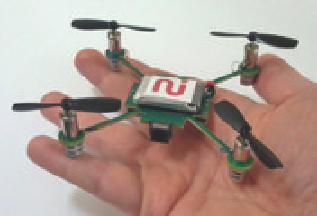Information Technology Reference
In-Depth Information
accelerometers
to measure changes in motion. Chips with all these function-
alities now cost less than $20. Similarly, the demand for smaller global posi-
tioning system chips to provide navigation systems in phones has brought
the price down from thousands of dollars to as little as $10. Finally, the
demand for better mobile phone cameras has led to the availability of cheap,
powerful imaging chips. As a result, there is now a thriving do-it-yourself
drone community. Hobbyist drone builders employ smart phone technology,
including low-cost sensors, cameras, low-power processors, and batteries.
Drone enthusiasts exchange information on DIYdrones.com, a website set up
by Chris Anderson of
Wired
magazine (
Fig. 16.8
). The site lists a large number
of nonmilitary, nonpolice uses of drones - including agriculture, search and
rescue, home movies, coverage of sports events, environmental monitoring,
and delivering medicines.
Fig. 16.8. The MeCam quadcoptor is a
miniature drone that can follow and
photograph you wherever you go and
then upload the video images to your
smart phone.
The Internet of Things
The growth of the Internet over the last thirty years has been dramatic.
From connecting a few thousand computers at research centers, the Internet
now connects billions of people through their personal computers, smart
phones, and tablets. Yet this is only the first step in connectivity. We can now
attach cheap electronic tags and sensors to objects and connect them to create
an even larger global network called the “Internet of Things.” The MIT engineer
Kevin Ashton first used the term in 1999. In his original definition, he said:
Today computers - and, therefore, the Internet - are almost wholly dependent
on human beings for information. Nearly all of the roughly 50 petabytes (a
petabyte is 1,024 terabytes [trillion bytes]) of data available on the Internet
were first captured and created by human beings - by typing, pressing a
record button, taking a digital picture or scanning a bar code.… The problem
is, people have limited time, attention and accuracy - all of which means they
are not very good at capturing data about things in the real world.… If we
had computers that knew everything there was to know about things - using
data they gathered without any help from us - we would be able to track and
count everything, and greatly reduce waste, loss and cost. We would know
when things needed replacing, repairing or recalling, and whether they were
fresh or past their best. The Internet of Things has the potential to change the
world, just as the Internet did. Maybe even more so.
5
After the revolutions caused by the World Wide Web and mobile, networked,
wireless devices, the Internet of Things represents the next disruptive technol-
ogy on the horizon. With more than fifty billion objects predicted to be con-
nected to the Internet by 2020, we will see a world in which everyday objects,
such as topics, cars, and refrigerators, can be interrogated for information.
Some of the smart devices will not only use sensors to get information but also
use
actuators
, devices that move or control things, to modify the environment.
“Intelligent houses” will be able to check on their inhabitants; water drainage
systems will know about storm threats and adjust accordingly; and businesses
will actively monitor supply chains so that they no longer run out of stock or
generate wasteful surpluses.

Search WWH ::

Custom Search